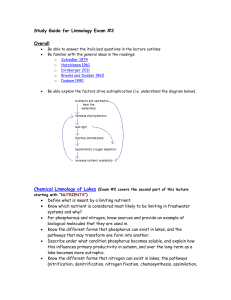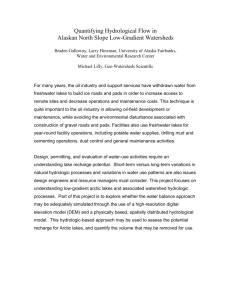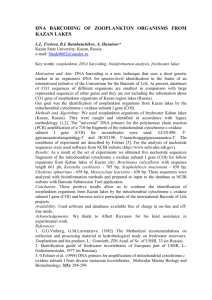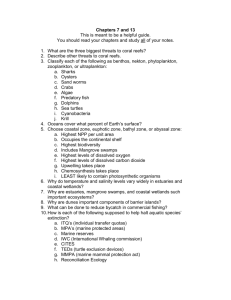italiano_ - Ev-K2-CNR
advertisement
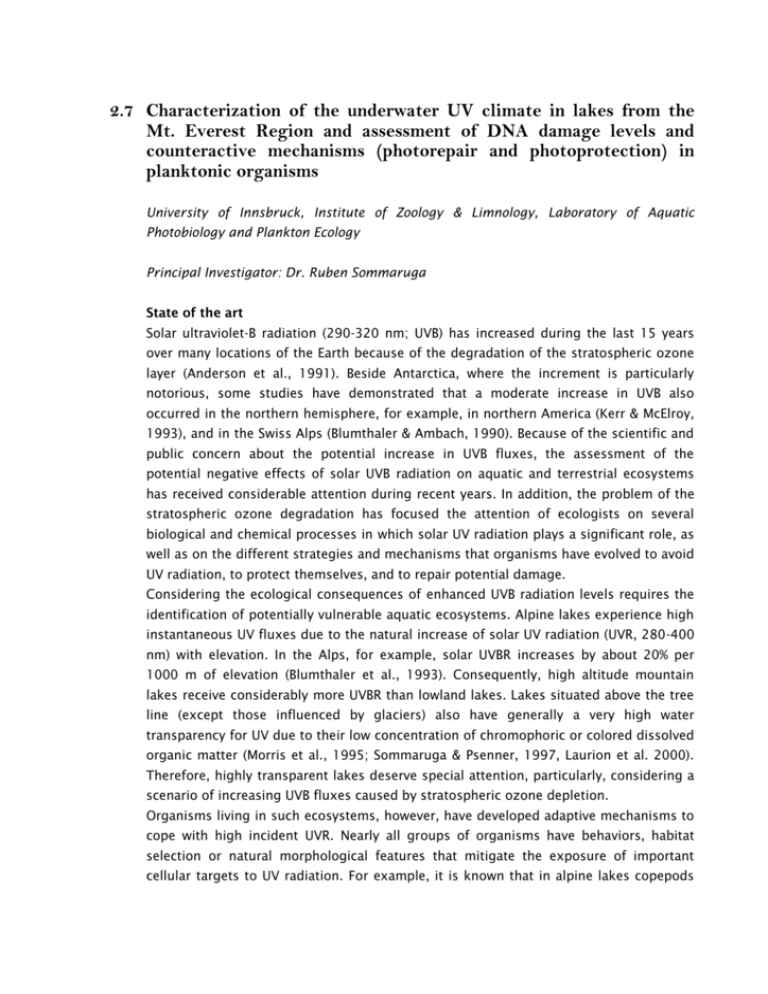
2.7 Characterization of the underwater UV climate in lakes from the Mt. Everest Region and assessment of DNA damage levels and counteractive mechanisms (photorepair and photoprotection) in planktonic organisms University of Innsbruck, Institute of Zoology & Limnology, Laboratory of Aquatic Photobiology and Plankton Ecology Principal Investigator: Dr. Ruben Sommaruga State of the art Solar ultraviolet-B radiation (290-320 nm; UVB) has increased during the last 15 years over many locations of the Earth because of the degradation of the stratospheric ozone layer (Anderson et al., 1991). Beside Antarctica, where the increment is particularly notorious, some studies have demonstrated that a moderate increase in UVB also occurred in the northern hemisphere, for example, in northern America (Kerr & McElroy, 1993), and in the Swiss Alps (Blumthaler & Ambach, 1990). Because of the scientific and public concern about the potential increase in UVB fluxes, the assessment of the potential negative effects of solar UVB radiation on aquatic and terrestrial ecosystems has received considerable attention during recent years. In addition, the problem of the stratospheric ozone degradation has focused the attention of ecologists on several biological and chemical processes in which solar UV radiation plays a significant role, as well as on the different strategies and mechanisms that organisms have evolved to avoid UV radiation, to protect themselves, and to repair potential damage. Considering the ecological consequences of enhanced UVB radiation levels requires the identification of potentially vulnerable aquatic ecosystems. Alpine lakes experience high instantaneous UV fluxes due to the natural increase of solar UV radiation (UVR, 280-400 nm) with elevation. In the Alps, for example, solar UVBR increases by about 20% per 1000 m of elevation (Blumthaler et al., 1993). Consequently, high altitude mountain lakes receive considerably more UVBR than lowland lakes. Lakes situated above the tree line (except those influenced by glaciers) also have generally a very high water transparency for UV due to their low concentration of chromophoric or colored dissolved organic matter (Morris et al., 1995; Sommaruga & Psenner, 1997, Laurion et al. 2000). Therefore, highly transparent lakes deserve special attention, particularly, considering a scenario of increasing UVB fluxes caused by stratospheric ozone depletion. Organisms living in such ecosystems, however, have developed adaptive mechanisms to cope with high incident UVR. Nearly all groups of organisms have behaviors, habitat selection or natural morphological features that mitigate the exposure of important cellular targets to UV radiation. For example, it is known that in alpine lakes copepods and flagellated phytoplankton, move away from the water surface at midday when sunlight irradiances are strongest (Tilzer, 1973; Halac et al., 1999; Tartarotti et al., 1999). Such an avoidance strategy may not be feasible in cases where the waterbody is relatively shallow and the water is highly transparent to UVR. Strong vertical mixing of the water column driven by wind-induced turbulence is an additional factor that may lower the effectiveness of the avoidance strategy. Other organisms are protected by living under stones or buried into the sediment. However, many species are either continuously exposed to high solar UV intensities (e.g. benthic cyanobacteria at the lakeshore), or intermittently, depending on the mixing conditions of the water column, (e.g. planktonic species). Ultraviolet radiation exerts negative effects either by direct damage to DNA, proteins, pigments and lipids, or indirectly through the generation of reactive oxygen species (Vincent & Roy, 1993). While UVB mainly causes damage by direct absorption, UVA (320400 nm) and also wavelengths in the visible range (400-700 nm, PAR) are more effective in exerting indirect damage, although the final mechanism will depend on the absorption characteristics of the chromophores. In any case, the synthesis or accumulation of photoprotective compounds that intercept wavelengths in the UV range (sunscreens) and dissipate the energy as heat without the formation of intermediate radicals would be beneficial for organisms exposed to high UVR. Several photoprotective compounds are known to absorb directly or indirectly the solar UV energy in aquatic organisms The occurrence of the yellow-brown pigment known as scytonemin is restricted to some species of cyanobacteria (Nägeli, 1849; Garcia-Pichel & Castenholz, 1991) where it is located in the extracellular polysaccharide sheath. Melanin is mainly found in the skin of aquatic vertebrates and in the cuticle of cladocerans crustaceans (Hebert & Emery, 1990), while the putative protective compound sporopollenin has been detected in the cell wall of some chlorophytes (Xiong et al., 1996). All these three photoprotective compounds act as direct filters of UVR. On the other hand, the photoprotective action of carotenoids is mainly related to their antioxidant properties (quenching of reactive oxygen species, Bidigare et al., 1993). Primary or secondary carotenoids are found mainly in phototrophic organisms but also in several planktonic crustaceans species (Brehm, 1938; Hairston, 1976) and bacteria (Mathews & Sistrom, 1959). The last group of photoprotective agents includes the UV-absorbing compounds known as mycosporine-like amino acids (MAAs). These compounds are widely distributed among marine organisms (Karentz et al., 1991; Dunlap & Shick, 1998). Information about the occurrence of mycosporine-like compounds in freshwater organisms is still scarce. These compounds have been reported recently for natural phytoplankton assemblages (Sommaruga & Psenner, 1997; Sommaruga & Garcia-Pichel, 1999), benthic cyanobacteria (Sommaruga & Garcia-Pichel, 1999), microalgae (Laurion et al. 2002), mixotrophic ciliates (Sommaruga unpub.), and cyclopoid and calanoid copepods (Sommaruga & Garcia-Pichel, 1999, Tartarotti et al. 2002). Interestingly, these compounds have not been found until now in Cladocera (including non-melanized forms, Tartarotti et al. 2002). The last line of defense against UVR exposure consists in repairing the damage after it has occurred. By far, the most common type of DNA damage induced by UVC and UVB is the formation of cyclobutyl pyrimidine dimers (CPDs) and pyrimidine (6-4) pyrimidone photoproducts. These lesions block DNA replication and transcription leading to mutagenic or lethal effects. Living organisms have evolved a specific mechanism for the repair of pyrimidine dimers, called photoreactivation. This mechanism involves a single enzyme (photolyase), which directly reverses the pyrimidine dimers into the two pyrimidine nucleotides by using the energy of near ultraviolet and visible light (Friedberg et al. 1995). Photolyase activity is widely distributed in nature and photoreactivation has been found in members of all kingdoms of life. Nevertheless, this mechanism is absent in many species (Sancar 1994) Recent investigations have shown that not all 3 main strategies to minimize negative effects from UV radiation are feasible or work efficiently. For example, as discussed above planktonic organisms from shallow and transparent lakes, will be still exposed to significant UV fluxes in deeper layers. In fact, availability of depth refugia (1% UV penetration depth:maximum depth is the main variable explaining the variability in MAAs concentration in populations of the copepod Cyclops abyssorum (Tartarotti et al. 2002). Investigations in shallow and transparent water bodies in Antarctica, also suggest that in cold lakes the main mechanism to repair DNA damage (i.e., photorepair) is significantly reduced at low temperatures (Rocco et al. 2002). Thus, synthesis and accumulation of photoprotective compounds might be the first line of defense in such aquatic ecosystems. This type of strategy may be particularly efficient when visual predators (e.g. fish) are absent as in natural remote lakes. Rationale to investigate the high-altitude lakes in the Mt. Everest region Although the “altitude effect” (i.e., the increase of UV radiation fluxes with altitude) is variable for different mountain regions (Sommaruga 2001) and has not been established for the Himalaya chain, assuming a conservative factor of 10% increase per 1000 m, imply that organisms living in lakes from the Mt. Everest region experience extreme high UV fluxes during the ice free season. In addition, preliminary measurements of DOC concentration (Bertoni et al. 1998) in some of those lakes suggest that they are very transparent to UV radiation. Finally, although phytoplankton species found in those lakes seems to be cosmopolitan (Manca et al. 1998), several zooplankton species are endemic of that region (Löffler 1968, Manca et al. 1994, 1998) and thus represent a unique opportunity to understand their autoecology, as well as to assess the strategies to minimize damage from UV exposure. Objectives and hypotheses The present proposal have as main objectives: 1) to evaluate the UV underwater climate in the same lakes selected by the Pyramid Limno Group (PLG, directed by Dr. Lami), in relation to their DOC content and absorption characteristics of the dissolved organic matter (i.e., the two main factors controlling the attenuation of UV underwater), 2) to assess the concentration and composition (only for MAAs) of photoprotective compounds in planktonic organisms (phytoplankton as source of these compounds and zooplankton) in the water column in some selected transparent lakes that offer different depth refugia (Cadastre # 9, 10, 66) having different maximum depth (Tartari et al. 1998b), 3) to establish the natural levels of DNA damage in representative zooplankton species of these 3 lakes, and 4) to test the efficiency of photorepair in those organisms. The main hypothesis to test is whether photoprotection (carotenoids and MAAs) represents the main strategy to minimize DNA damage in zooplankton from UVtransparent and cold lakes of the Himalaya region. To my best knowledge, parallel assessment of the parameters indicated in objectives 2, 3, and 4 has never been done before for other lakes/organisms and thus will represent the first study to assess natural DNA damage levels of zooplankton in relation to the main strategies to minimize it. In particular, the planned measurements in lakes having different maximum depth will give an excellent chance to test this hypothesis in lakes having different depth refugia and for species having different types of photoprotective compounds (e.g., melanized forms in Daphnia tibetana but not in D. longispina, (Manca et al. 1994). In these three lakes, similar zooplankton community structure is found (Tartari et al. 1998b). Characterization of the underwater UV climate (objective #1) will not only provide a basis to assess the degree of UV stress (i.e., UV penetration in relation to max depth) in those lakes, but also will complement the activities of the PLG providing information necessary for potential reconstruction of historical UV climate in those ecosystems. Work plan, methodology, and timetable Work plan Field work will be done during September-October (post-monsoon period) together with the PLG. Although these are not the months with the highest incident solar radiation, they are characterized by less rain and clear sky conditions as indicated by the higher clearness index of these months compared to the rainy season (Tartari et al. 1998a). Measurements of UV penetration, natural fluorescence, DOC concentration and CDOM absorption will be done in the same lakes selected by the PLG (see proposal by Dr. Lami). Samples for Chlorophyll-a and MAAs in seston estimations will be collected in the 3 selected lakes at 3 discrete depths (surface, middle, and bottom) with a water sampler. Zooplankton will be collected by vertical tows using a 55-µm-mesh plankton net. Arctodiaptomus jurisvitchii and cladoceran species will be narcotized and counted and sorted under a dissecting microscope. A given number of individuals will be stored in triplicate at -20 °C and liquid N for MAA analysis, carotenoids, DNA damage, and photolyase activity determinations (see below). Materials and Methods UV underwater measurements. Profiling of the water column will be performed with a PUV-501 submersible radiometer from Biospherical Instrument (San Diego, CA). This instrument measures the downwelling radiation at four nominal wavelengths (305, 320, 340 and 380 nm) with a full width half maximum waveband of 10 nm, and the depth (cm resolution) by means of a pressure transducer. The instrument also measures PAR (400-700 nm) and natural fluorescence. The attenuation coefficient (Kd) for UV wavelengths and PAR will be calculated from the slope of the linear regression of the natural logarithm of downwelling irradiance versus depth. Dissolved organic carbon (DOC) concentration. Subsamples for DOC analysis will be filtered on the same day through a previously combusted (2 h at 475°C) GF/F filter (Whatman) placed on a stainless steel syringe holder (Poretics, 25 mm diameter) and collected in combusted (same as above) brown glass vials with Teflon-faced screw caps (Supelco). Samples will be preserved with HCl p.p.a and stored at 4 oC until further analysis at Innsbruck (Laurion et al. 2000). Dissolved organic carbon will be measured (direct method) with a high temperature catalytic oxidation method using a Shimadzu TOC Analyzer Model 5000. The instrument is equipped with a Shimadzu platinizedquartz catalyst for high-sensitivity analysis. Blank analyses using Milli-Q water yield usually DOC values of between 0.02 and 0.04 mg L -1. Controls will be done also with the water available at the pyramid laboratory. Absorption spectra of DOM. The filtrates (same as above) will be stored in the same type of vials but will be only frozen. Absorption measurements between 250 and 750 nm will be done in Innsbruck using a Hitachi U-2000 double beam spectrophotometer and 10cm quartz cuvettes. These measurements will be referenced against GF/F-filtered, Milli-Q water. MAAs analysis. For the analysis of MAAs in seston (metazooplankton will be prescreened with a net sieve of 85 µm mesh), 1-2 L of water (depending on cell density) will be filtered at the Pyramid laboratory onto Whatman GF/F filters (25 mm diameter). A known number of zooplankton individuals will be carefully picked-up and placed on directly in a Eppendorf vial. The vials will be transported in a liquid nitrogen container until their subsequent extraction previous lyophilization at Innsbruck. Extraction will be done with aqueous-methanol (MeOH, HPLC grade) following Tartarotti & Sommaruga 2002). All extracts concentrated by freeze-drying will be resuspended in 100-200 µl of 20% methanol for analysis by high performance liquid chromatography (HPLC). For separation of MAAs, 20-100 µl aliquots will be injected in a Phenomenex "Phenosphere" C-8 column (4.6 mm ID x 250 mm) for isocratic reverse-phase HPLC analysis with a mobile phase of 55% aqueous-MeOH plus 0.1% acetic acid. The MAAs in the eluate will be detected by online diode array absorption spectroscopy. The MAAs will be identified by co-chromatography and comparison of wavelength ratios with primary and secondary standards (Sommaruga & Garcia-Pichel, 1999). Concentrations of the different MAAs will be normalized to the chlorophyll-a in seston or to dry weight in the case of zooplankton (see below). Chlorophyll-a analysis. For chlorophyll-a (Chl-a) estimation, 1 to 2 liters will be filtered onto Whatman GF/F filters (25 mm diameter) at low pressure (0.3-0.4 atm) and the filters will kept frozen in liquid Nitrogen. In the laboratory, the filters will be extracted overnight with 90% acetone and sonicated for 2 min with a tip sonicator (Bandelin Inst.) on an ice bath. Next the extracts will be filtered through an Anodisc filter of 0.1-µm pore-size (Whatman) and the absorbance measured in a double beam spectrophotometer (Hitachi U-2000) against an acetone blank using cuvettes of 5 cm pathlength. The equations of Jeffrey and Humphrey (1975) will be used to calculate the concentration of pigments. Zooplankton biomass. The biomass of the zooplankton in each vial will be estimated knowing the abundance of the different species and the relationship between length and dry weight calculated for the species/stages (copepods of the same stage will be sorted out in the same vial) or if not available for Arctodiaptomus jurisovitchii, I will obtain an approximation using the relationship for calanoid species of similar size. The biomass of cladocerans will be calculated following Bottrell et al. (1976). Total carotenoids in zooplankton. As for MAAs, zooplankton will be sorted out in vials, transpoted in a liquid N container and freeze-dried at Innsmbruck. Carotenoids will be extracted with absolute ethanol for 24 h (dark conditions, 20°C) or until to obtain a complete extraction as checked by direct observation. The optical density of the extract will be measured in the same spectrophotometer as above against an ethanol blank. The carotenoid concentration will be calculated according to the following formula: Carotenoid concentration (µg mg-1 dry weight)= (D* V* 104)/(E*W) where D is the absorbance at peak, V is volume of ethanol (ml), E is the extinction coefficient set at 2500 and W is the dry weight of the sample (mg) (Hairston, 1978). Direct dosage of photolyase in zooplankton species. These measurements will be done by Dr. Oscar Oppezzo at the Comisión Nacional de Energía Atómica, Departamento de Radiobiología, Buenos Aires, Argentina. Shortly, the activity of DNA photolyase will be assessed by measuring the light-dependent loss of thymine containing pyrimidine dimers from UV-irradiated DNA. The method is described in detail in Rocco et al. (2002). Determination of DNA damage. These analyses will be done by Dr. Anita Buma at the University of Groningen, Biological Center, The Netherlands. The protocol used to determine the concentration of T<>T dimers in DNA from zooplankton species will be a modification of the method described by Vink et al. (1994). This modification has been successfully applied to microzooplankton (heterotrophic flagellates and ciliates) and is described in detail in Sommaruga & Buma (2000).


